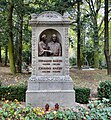Main cemetery in Szczecin
The main cemetery in Stettin , in Polish : Cmentarz Centralny w Szczecinie , is the municipal cemetery in Stettin (Poland). With an area of over 167.8 hectares and more than 300,000 graves, as well as its constant growth, it is the largest cemetery in Poland and the third largest in Europe.
history
The main cemetery in Szczecin was rebuilt in 1901. The design model was the Ohlsdorf cemetery in Hamburg . Since then, it has been in continuous use and has the Polish status of a protected national monument.
The older part of the cemetery was established in a new area on the western outskirts of the city. It was designed by Wilhelm Meyer-Schwartau , a renowned architect from Szczecin at the time. The landscape architect Georg Hannig carried out the design of the green spaces . During the same period, Wilhelm Meyer-Schwartau also designed the neo-romantic chapel and a monumental 77-meter-long entrance avenue from the main gate to this chapel. There are a total of eleven avenues leading into the cemetery as park paths. The aim was to use the natural features to fit the entire facility into the existing landscape. The cemetery should be both a picturesque park and have the character of a “memorial park”. Most of the paths in the old part of the cemetery are twisted and run through it in a network of small circles. The main path, flanked by plane trees , leads from the central entrance directly to the chapel and this main axis connects and divides the old and the new area of the park cemetery.
In 1929 the crematorium was built near the chapel . In 1930 a second chapel was built in the modern style when it was extended to the west. This was destroyed by the effects of war in World War II and finally demolished around 1984. The main chapel was destroyed by fire in 1981 and it took 13 years to rebuild. Even today there is only one chapel in the cemetery, opposite of which there is a water basin with a fountain.
The new western part of the cemetery was established in 1930 on a site that was formerly used by the military. Most of the paths here are straight and parallel to two streams that run through the entire territory.
There are many places of historical interest on site, such as a lapidarium with old tombstones and grave sculptures. There is also an old windmill here, which is now part of a garden center. There are graves of remarkable people, such as artists and politicians.
Monuments
There are monuments
- for the fallen and war veterans ,
- for the sailors who stayed at sea,
- for unborn children and
- for the victims in the concentration camps .
Probably the most famous monument is the Pomnik Braterstwa Broni (Monument to the Brotherhood of Arms), which was designed in 1967 by Sławomir Lewiński. It's a military memorial depicting a winged hussar, and it stands on a hill on the main axis. There is a great view of the main chapel from the hill.
The main cemetery itself is a colossal park in the center of the city with a large number of old trees of various kinds and evergreen conifer bushes cut into figures. It is thus like a large botanical garden, which is not only unique in Szczecin with this original collection of trees and bushes. Some parts of the cemetery are still in a very natural state with thickets and meadows. Particularly noteworthy are the green belts along the two streams. This creates very important habitats for small animals, birds and insects in the middle of the city. There are foxes, rabbits, hedgehogs, wild ducks and red squirrels, so there is also an educational trail with photos and information about these wild animals in the cemetery.
On the other hand, the main cemetery is itself a cultural monument; after it was set up a hundred years ago in German Szczecin, it is still used in Polish Szczecin and visited by tourists.
Series of images
Web links
Individual evidence
Coordinates: 53 ° 25 ′ 14 ″ N , 14 ° 31 ′ 24 ″ E









